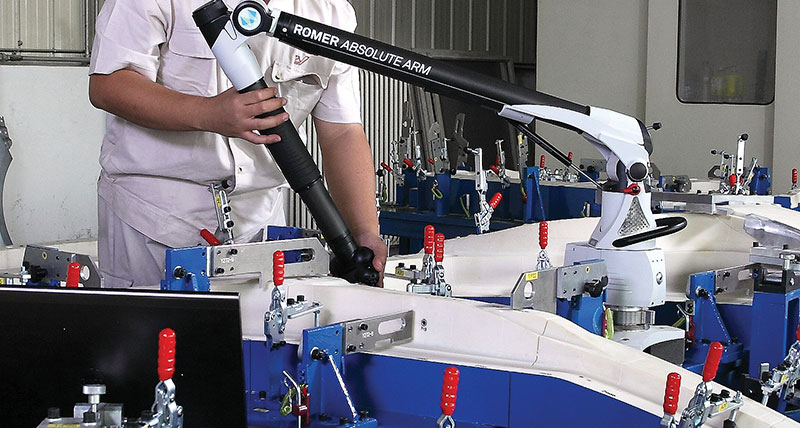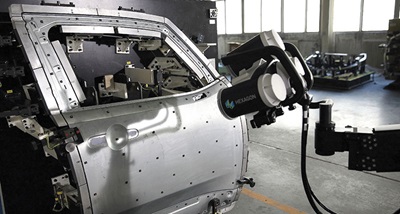Unceasing dedication to product quality
Tianjin Motor Dies Co. Ltd., - China
Contact us

Quality control throughout the die-production process ensures a continued industry-leading position for Tianjin Motor Dies
Tianjin Motor Dies Co. Ltd., founded in 1995, celebrated its twentieth anniversary in April 2015. Currently, Tianjin Motor Dies has more than ten plants in China and has even set up manufacturing facilities in Germany. The company, one of China's largest motor die manufacturers, has now begun to impact the global dies market in earnest. “The die manufacturing industry in China has seen rapid development, especially in the area of quality. 30 years ago, when one walked along the street, it was easy to pick out the domestically-manufactured car models from the imported models, sometimes even from afar. However, today, it is difficult to tell the domestic model from the imported model even with both parked right in front of you. This is the result of quality improvements in Chinese die manufacturing,” says Chang Shiping, Chairman of Tianjin Motor Dies.
“The die manufacturing industry in China has seen rapid development, especially in the area of quality. 30 years ago, when one walked along the street, it was easy to pick out the domestically-manufactured car models from the imported models, sometimes even from afar. However, today, it is difficult to tell the domestic model from the imported model even with both parked right in front of you. This is the result of quality improvements in Chinese die manufacturing,” says Chang Shiping, Chairman of Tianjin Motor Dies.More than 70% of an automobile body is produced using the die stamping process. The first step in the four-stage process of automobile manufacturing (stamping, welding, painting and final assembly) is the stamping; flat steel sheets are cut or punched using pre-made dies to create various body components. In China’s automobile manufacturing industry, over one-third of dies are manufactured domestically. This makes for significantly lower manufacturing costs and has contributed to the entry of the sedan into the average household three years earlier than expected. The move by China's automobile die manufacturing industry towards quality manufacturing has not only lowered the costs of automobile manufacturing in China, but has also enhanced the quality of domestic makes. Today, some highly-competitive Chinese die manufacturers have set their sights further afield and are seeking a share of the global market on the basis of these cost advantages.
“If we have to pinpoint a single determining factor for the success of Tianjin Motor Dies, it would be the company's extraordinary pursuit of measurement and quality control solutions. And that is what we call an unceasing dedication to product quality.” In its transformation from state-owned firm to private enterprise, Tianjin Motor Dies has shown clear success, but this is far from accidental. Since its founding, the company has relied on technical innovation and quality production as the foundation for its success, and Hexagon Manufacturing Intelligence has played an indispensable role throughout this process.
 Tianjin Motor Dies’ partnership with Hexagon and its forerunner businesses began in 1995, when the company was still a state-owned enterprise. Since its foundation, the company selected – without any hesitation – DEA range gantry coordinate measuring machines (CMMs). From the R&D of dies to process measurement, die adjustments and all the way to die testing, the automated 3D precision testing functions of these gantry CMMs were used in every step of Tianjin Motor Dies' development to ensure the quality of its production.
Tianjin Motor Dies’ partnership with Hexagon and its forerunner businesses began in 1995, when the company was still a state-owned enterprise. Since its foundation, the company selected – without any hesitation – DEA range gantry coordinate measuring machines (CMMs). From the R&D of dies to process measurement, die adjustments and all the way to die testing, the automated 3D precision testing functions of these gantry CMMs were used in every step of Tianjin Motor Dies' development to ensure the quality of its production.With the rapid development of China's automobile manufacturing industry, requirements for die precision and turnaround times are also becoming more demanding. Die measurement and quality assurance solutions are becoming increasingly important due to the complexity of die manufacturing. The partnership between Tianjin Motor Dies and Hexagon has also become closer over time.
At the Tianjin plant alone, the five measuring rooms have all been equipped with DEA gantry CMMs, mainly for inspecting dies, fixtures and other die-making equipment. At the same time, on the factory shop floor, Tianjin Motor Dies has also commissioned the ROMER Absolute Arm portable CMM, while the WLS400M white light measurement system is installed in the die processing and manufacturing section.
Tianjin Motor Dies is a design and manufacturing company that has integrated the processes of die casting, testing and clipping for automotive body parts. The company is well-versed in the use of quality control methods over the design, manufacturing and aftersales service stages.
At the company’s busy factory shop floor, the ROMER Absolute Arm is used for line measurement. In addition, the portability of the articulated arm CMM also allows for easy transfer to other plants or even customer premises. The measuring arm uses absolute encoder technology to provide quick measurement without referencing or warm-up time. This makes the device useful for the inspection of single samples. The carbon-fibre construction of the articulated arm means that the device is light and suitable for manual use.
“The shape of the die is not exactly the same as the shape of the final product, as the sheet material will always ‘bounce back’ to a certain degree. Therefore, quality control for the die equipment must be highly precise; whether the die equipment meets specifications depends on the quality of the final product, the stamped sheet metal,” continues Tianjin Motor Dies founder Chang Shiping, offering penetrating insight into the die quality control process.
 “Today, quality requirements for die manufacturing parts have become higher. In order for us to enhance measurement efficiency and realise full control over the dimensions of curved surfaces and smaller details, we began to use non-contact white light measurement systems, which are small in size and cost-efficient to operate. Most importantly, the systems are high in efficiency, quick in data processing and comprehensive in analyses. They have contributed greatly in our efforts to enhance testing efficiency with regard to die parts and our manufacturing equipment.”
“Today, quality requirements for die manufacturing parts have become higher. In order for us to enhance measurement efficiency and realise full control over the dimensions of curved surfaces and smaller details, we began to use non-contact white light measurement systems, which are small in size and cost-efficient to operate. Most importantly, the systems are high in efficiency, quick in data processing and comprehensive in analyses. They have contributed greatly in our efforts to enhance testing efficiency with regard to die parts and our manufacturing equipment.” As Tianjin Motor Dies continues to grow and develop, the company has chosen to use Hexagon’s WLS400M non-contact white light measurement system. In addition to high efficiency and the comprehensive collection of point cloud data, the solution also provides manufacturers with colour difference reports for various manufacturing equipment and processes, as well as the statistical analysis of batch testing results, hence providing the user with a highly accessible, efficient and quick means of data analysis.
